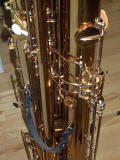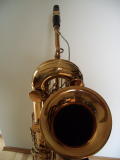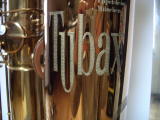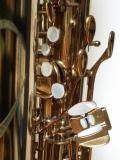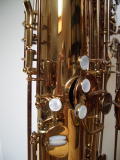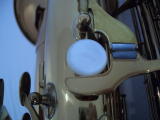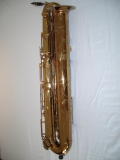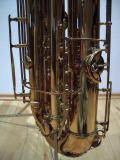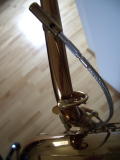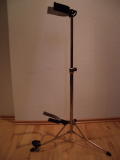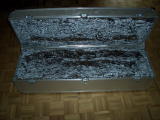The Tubax

What is a Tubax?
The Tubax is a newly designed contrabass saxophone tuned in Eb, one octave below the baritone saxophone. It has been developed and built by Benedikt Eppelsheim of Munich, Germany. Meanwhile, he offers even lower Tubaxes tuned in C and Bb, the latter finally realizing the subcontrabass saxophone, planned 150 years ago, but never built — upto now.
The bore
The Tubax has a narrower bore than a conventional contrabass saxophone and thus needs much less air to blow, but is also not as powerful as a conventional contrabass sax. But this is balanced by its much better handling and agility. The sound is more like a baritone saxophone which magically can descend one octave lower one is used to. Also due to its narrower bore it's easy to play very softly even in its lowest register.
Some measures
Instead of being folded twice, the Tubax is folded four times (reminiscent of a contrabassoon) which makes it only 114 cm high, not much bigger than a baritone saxophone, but having twice the tube length! The lower end of the tube has a diameter of 10 cm and the bell is 20 cm in diameter. The Tubax weighs only 9.5 kg, which makes it almost possible to play it standing using a strap. But normally it is played sitting, standing on the floor on a peg.
Looks
The Tubax has a very dark lacquer, much like old American saxophones. Benedikt prefers this lacquer, but of course other finishes are possible, since each Tubax is custom-made. I saw some very nice designs (partly mattfinished silver plating, partly polished silver plating) and engravings in his shop. The keys are made of mother-of-pearl, even the rollers of the pinky keys.
Range
 The Tubax has
a normal written range from bb to f#3,
like any other saxophone. (It has no low A key.) However, it has
a special vent key to facilitate overblowing.
You can use music written for (string) contrabass, tuba, or contrabassoon
(bass clef transposing one octave down) and read it imagining treble clef
(of course caring for accidentials) and it will sound right, even the
octave is correct. It's the same trick as reading bass clef music with an
Eb baritone saxophone.
The Tubax has
a normal written range from bb to f#3,
like any other saxophone. (It has no low A key.) However, it has
a special vent key to facilitate overblowing.
You can use music written for (string) contrabass, tuba, or contrabassoon
(bass clef transposing one octave down) and read it imagining treble clef
(of course caring for accidentials) and it will sound right, even the
octave is correct. It's the same trick as reading bass clef music with an
Eb baritone saxophone.
Mouthpiece and reeds
The Tubax can be played with a normal baritone saxophone mouthpiece. It's not recommendable to use a metal mouthpiece since the sound easily gets to sharp or thin, a bigger rubber/ebonite mouthpiece is much better. Eppelsheim optionally supplies a Nr. 63 Zinner mouthpiece which fits very well. I'm using LaVoz medium hard reeds with it.
Octave vents
One of the many innovations Benedikt Eppelsheim has done when designing the Tubax is the system of 3 automatic octave vents. The acoustically problematic (but just about tolerable) traditional 2 vent system becomes unusable with the bigger saxes, especially the middle d sounds thin using the standard fingering. Eppelsheim's system has an own octave vent for middle c# (long), d, and eb, switched automatically when pressing right hand key 6. The middle octave vent is employed from e to g# and the upper vent kicks in for higher notes like on a traditional sax.
Altissimo vents
The Tubax has a special vent key (controlled by the left thumb) to facilitate overblowing. Using this key altissimo notes upto c4 or d4 respond as easy as notes from the standard range without having to change the embouchure. Some higher notes (e4 and f4) have weak resonances, so Benedikt and I experimented with adding another altissimo vent. This vent is placed very close to the mouthpiece and is controlled via a bowden wire (a flexible release for a camera) by the right thumb. Now a continuous range of about 4 octaves is easily playable (and certainly more, but control becomes difficult) Here is a summary of the altissimo fingerings I use.
Other innovations
The four-tube design requires transferring forces by other means than standard levers, which are too heavy and accident sensitive. Benedikt uses connecting rods (as can be seen in the pictures below) to connect the right hand palm keys to the pads on the left tube. He also uses counternuts to fix the screws holding the axles. When designing the tone hole displacements he included the temperature gradient between the player's mouth and the ambient temperature in his calculations.
In summary, Benedikt Eppelsheim is certainly one of the most innovative and competent woodwind instrument makers today. I hope to contribute to his fame with this page somewhat and wish him my very best!
Pictures
Sound samples
- Ballad of Sexual Slavery by Kurt Weill
- Harlem Nocturne (shows altissimo range)
- Bourrée I from Cello Suite Nr. 4 by J.S. Bach
- Funky bass line
Arrangements
Links
- Benedikt Eppelsheims home page
- Contrabass mania — all kinds of (mainly woodwind) contrabass instruments
- Jay C. Easton — he plays all sizes of saxophones and owns a Bb subcontrabass Tubax
